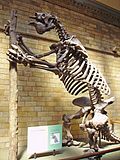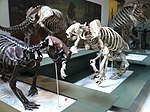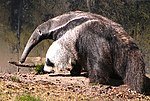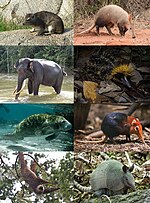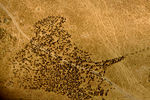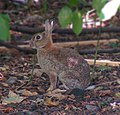Xenarthra (/zɛˈnɑːrθrə/; from Ancient Greek ξένος, xénos, "foreign, alien" + ἄρθρον, árthron, "joint") is a major clade of placental mammals native to...
26 KB (2,789 words) - 01:54, 27 October 2024
three major subdivisions or lineages of placental mammals: Boreoeutheria, Xenarthra, and Afrotheria. All of these diverged from common ancestors. 2022 studies...
23 KB (2,336 words) - 07:45, 25 October 2024
species of which exist solely on sloths. Sloths belong to the superorder Xenarthra, a group of placental mammals believed to have evolved in the continent...
50 KB (5,432 words) - 03:14, 21 October 2024
anatomy with "edentate" mammals (now recognised as members of the order Xenarthra) in the collection of the Paris museum, correctly recognised that the...
51 KB (5,555 words) - 17:11, 2 November 2024
placental mammals in the order Cingulata. They form part of the superorder Xenarthra, along with the anteaters and sloths. 21 extant species of armadillo have...
36 KB (3,519 words) - 09:22, 30 October 2024
and Pampatheridae. Cingulata is itself within the basal mammal group Xenarthra, which includes an array of American mammal groups like Vermilingua (anteaters)...
117 KB (12,956 words) - 12:36, 14 October 2024
Cingulata, part of the superorder Xenarthra, is an order of armored New World placental mammals. Dasypodids and chlamyphorids, the armadillos, are the...
20 KB (1,370 words) - 17:35, 1 October 2024
sloths are a diverse group of extinct sloths in the mammalian superorder Xenarthra. They varied widely in size with the largest, belonging to genera Lestodon...
58 KB (5,999 words) - 14:37, 4 November 2024
share superorder Xenarthra (cladogram below) with the Cingulata (whose only extant members are armadillos). The two orders of Xenarthra split 66 million...
50 KB (5,482 words) - 08:30, 24 August 2024
suborder of the order Xenarthra, while some more recent classifications regard Pilosa as an order within the superorder Xenarthra. Earlier still, both...
10 KB (617 words) - 19:35, 7 October 2024
DNA from the extinct South American giant glyptodont Doedicurus sp. (Xenarthra: Glyptodontidae) reveals that glyptodonts evolved from Eocene armadillos"...
18 KB (1,522 words) - 12:36, 14 October 2024
(magnorder) of placental mammals containing the cohorts or superorders Xenarthra and Afrotheria. These groups originated and radiated in the South American...
9 KB (559 words) - 19:00, 22 September 2024
reveal three major groups or lineages of placental mammals—Afrotheria, Xenarthra and Boreoeutheria—which diverged in the Cretaceous. The relationships...
222 KB (23,150 words) - 10:54, 2 November 2024
De Iuliis, Gerardo (January 2006). "Eremotherium Laurillardi (Lund) (Xenarthra, Megatheriidae), the Panamerican giant ground sloth: Taxonomic aspects...
58 KB (7,056 words) - 14:36, 4 November 2024
also known by a number of indigenous names. Anteaters are part of the Xenarthra superorder, a once diverse group of mammals that occupied South America...
39 KB (4,538 words) - 21:37, 27 May 2024
Paleobiota of the La Brea Tar Pits (section Xenarthra)
A list of prehistoric and extinct species whose fossils have been found in the La Brea Tar Pits, located in present-day Hancock Park, a city park on the...
161 KB (5,653 words) - 12:35, 2 November 2024
Mammal classification (section Xenarthra)
reveal three major groups or lineages of placental mammals, Afrotheria, Xenarthra, and Boreoeutheria. which diverged from early common ancestors in the...
76 KB (6,393 words) - 21:36, 28 September 2024
The class Mammalia (mammals) is divided into two subclasses based on reproductive techniques: monotremes, which lay eggs, and therians, mammals which give...
24 KB (1,779 words) - 16:52, 22 October 2024
diverging cingulate (Xenarthra: Peltephilidae) from the Late Oligocene of Bolivia and considerations regarding the origin of crown Xenarthra. Bulletin of the...
10 KB (1,044 words) - 04:30, 8 July 2024
Scillato-Yané; Esteban Soibelzon (2015). "A Peculiar New Pampatheriidae (Mammalia: Xenarthra: Cingulata) from the Pleistocene of Argentina and Comments on Pampatheriidae...
8 KB (763 words) - 11:03, 9 October 2024
touch their young without causing injury. Myrmecophagids belong to the Xenarthra, formerly known as Edentata, which also includes sloths and armadillos...
5 KB (468 words) - 04:26, 23 February 2024
Ear Region of Edentates and the Phylogeny of the Tardigrada (Mammalia, Xenarthra)". Journal of Vertebrate Paleontology. 15 (3): 672–705. Bibcode:1995JVPal...
12 KB (1,033 words) - 21:20, 3 July 2024
Preptotheria (section Magnorder Xenarthra)
Preptotheria is a superorder of placental mammals proposed by McKenna & Bell in their classification of mammals. The Linnean taxonomy of Preptotheria according...
2 KB (148 words) - 18:22, 6 July 2023
some modern armadillo species, and they are classified in the superorder Xenarthra alongside sloths and anteaters. Being a glyptodont, it was a rotund animal...
29 KB (3,246 words) - 20:52, 26 August 2024
(2024-03-18). "Nomenclatural history of Megalonyx Jefferson, 1799 (Mammalia, Xenarthra, Pilosa, Megalonychidae)". ZooKeys (1195): 297–308. Bibcode:2024ZooK.1195...
17 KB (1,524 words) - 14:39, 4 November 2024
2024). "Nomenclatural history of Megalonyx Jefferson, 1799 (Mammalia, Xenarthra, Pilosa, Megalonychidae)". ZooKeys (1195): 297–308. Bibcode:2024ZooK.1195...
220 KB (22,673 words) - 15:16, 3 November 2024
Taumacera (redirect from Xenarthra (beetle))
Thunberg, 1814 Type species Taumacera deusta Thunberg, 1814 Synonyms Xenarthra Baly, 1861 Doridea Baly, 1864 Platyxantha Baly, 1864 Thaumacera Gemminger...
7 KB (404 words) - 19:08, 17 December 2021
(November 2019). "A reappraisal of the phylogeny of Mylodontidae (Mammalia, Xenarthra) and the divergence of mylodontine and lestodontine sloths". Zoologica...
3 KB (239 words) - 08:14, 18 May 2024
includes anteaters. They belong to the super order Xenarthra, which includes the Cingulata. Xenarthra are edentate or toothless. They lack incisors and...
10 KB (1,086 words) - 07:13, 2 October 2024
Haile Quarry site (section Xenarthra)
The Haile Quarry or Haile sites are an Early Miocene and Pleistocene assemblage of vertebrate fossils located in the Haile quarries, Alachua County, northern...
7 KB (641 words) - 02:31, 1 May 2024




